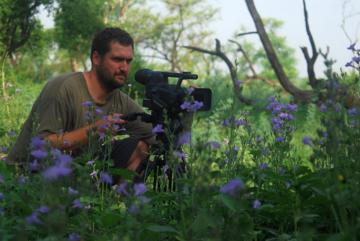
Some questions about Kunság – The Secret Lif Of Hungarian Puszta, Szabolcs Mosonyi's documentary
Mr Mosonyi, Why did you choose this interesting subject for your documentary?
We are preparing a series, for Hungarian Television that shows Hungary's wildlife in four parts. They separately present Hungary's four main regions. The first part, that presented in Sondrio Festival two years ago, is about the living water habitats of the river Danube with the title: Szigetköz. The one that deals with the flora and fauna of the dry Hungarian Puszta, is the second episode. We are preparing the third part dealing with the lakes and marshes. The last part will be about the mountains.
How long did you stay in the Hungarian Puszta to shoot your film?
It took us to shoot the film two years, and the post-production took an additional half a year. For this filming we did not need to travel far because the area where we mostly worked is in the Kiskunsági Nemzeti Park, that is near to Budapest where we live.
Were there any problems? What were the most beautiful days/aspects of your journey/work?
In the film we would have liked to show the life of the common spoonbill colony that was built in the reed. Unfortunately a storm destroyed all the nests with eggs and nestling. This was most unfortunate. In the last few years the storms are stronger in Hungary probably due to the climate change. Because of this the winters are getting milder and less snow falls. So little snow fell in two years on the Hungarian Puszta that the winter scenes that were needed in the film had to be shot in two weeks. We saw the long tale mayflies swarming at the Tisza River many times already but this is an unique experience still now. It is the largest mayfly in Europe, their wedding dance is known as the blooming of the Tisza River, when millions of insects cover the water in sunset.
The other big experience was the mating flight of the short-eared owl (Asio flammeus). The male owl knocks together his wings in the air as if he would clap. We never saw this before and only a few people including birdmen saw it ever. It was great luck that we could film this scene.
What about the golden jackal?
By the middle of the last century, the golden jackal became extinct in Hungary. As of the 1980s onwards the jackal began to spread from south to north. Today it can be found in almost every corner of Hungary. The golden jackal is very fond of sparsely wooded areas, and lives especially in the lowlands and lower hill areas. Nevertheless, since they are very shy and cautious animals because people are hunting them, they are rarely in front of people's eyes. It is very difficult to observe and film them. For filming these scenes, we used trail cameras and dug in the ground, odor-free hides. These hides have a photo-through window and a 5 meter high chimney to take away the human smell.
What do you think about the Sondrio Festival?
About ten years ago I was in the Sondrio Festival and I am still happy to remember it. The city is located in beautiful surroundings and the festival organizers were very attentive, hospitable to us. I really liked that there was a great interest towards the films, many people saw them.
In 2014 you won the “Regione Lombardia” award, were you excited about?
It was a big surprise and a great pleasure for me to have received this award. Unfortunately, I could not personally collect it, because before the festival I had a car accident and I had not fully recovered yet at that time.
What future projects for your work do you have?
Now we are working on a film about the Lake Balaton, which is Central Europe's largest lake. This will be similar nature film like the Kunság or the Szigetköz.
In addition to the nature films we produce environmental and nature conservation films about saving rare plants and animals with various topics. Most of them are financed by the European Union LIFE projects.